Perennialist savants are able to reach out through physical and extra-physical frequency waves to communicate meanings and energy to and elicit similar elements from another entity (person, object, event). They receive and transmit using resonating frequencies which are "invisible" or "inaudible" to ordinary persons. What is called "receiving inspiration" is actually the ability of a seeker to register frequencies of thought, sound, and energy from Higher Beings--carnate and discarnate--which are indiscernible to untrained persons.
|
"For though I see one to speak, teach, preach, and write of God, and though I hear and read the same, yet this is not sufficient for me to understand him; but if his sound and spirit out of his signature and similitude enter into my own similitude, and imprint his similitude into mine, then I may understand him really and fundamentally, be it either spoken or written, if he has the hammer that can strike my bell."Jacob Boehme, The Signature of All Things |
To a person who hasn't developed the capability of using extra-physical senses such as inspiration, intuition, and higher awareness, these concepts make little if any sense.
A seeker participating in the
preparatory phase of the Perennial Tradition must work to create a dynamic channel of creative inspiration between spiritual realities and earthly concerns.  She does not try to contact a spiritual current so she can fill up a "pond" for her personal enjoyment; such a dead pool soon stagnates. It must be a living, moving stream which originates in the higher dimension and flows continuously to become transmuted into an effective life force. She does not try to contact a spiritual current so she can fill up a "pond" for her personal enjoyment; such a dead pool soon stagnates. It must be a living, moving stream which originates in the higher dimension and flows continuously to become transmuted into an effective life force.
| "You ask me what led to our correspondence: it was the sentiments of benevolence throughout your works, to which it is impossible to remain a stranger, when one has chords in one's own soul pitched to the same key, which drew me to you. "Saint-Martin and Kirchberger, Theosophic Correspondence |
|
At present, most humans no longer understand the real meaning of "inspiration." 1 They've been conditioned to believe that it's merely a mild form of positive affect, as in the phrase: "That music is certainly inspiring." Assuming that inspiration is nothing more than a heightened emotion produced by certain experiences, people fail to search for the genuine essence of inspiration. So they listen to music or look at selected art objects, experiencing heightened emotion, and presume that that is all there is to inspiration.
In his dialogue Ion, Plato refers to the ordinary conception of inspiration as a sort of second-hand aftereffect in which a genuinely inspired person produces a work of art to which enthusiasts are drawn. Plato explains to Ion, a pretentious stage reciter of Homeric verse, that his attraction to Homer's works is not true inspiration but only a kind of secondary effect like a magnetized metallic ring to which, in turn, other rings fasten because of the original magnetic effect.
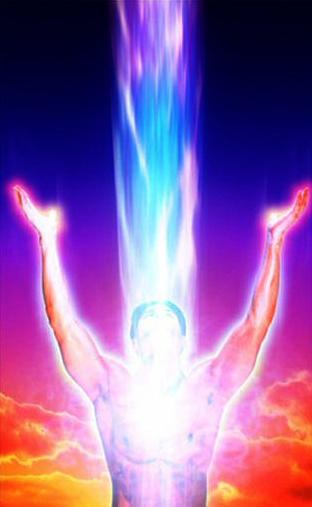
Inspiration is a spiritual faculty and power which has been forsaken and overlooked through ignorance and neglect. An act of inspiration occurs when a person allows a known or unknown 2 entity (Form, personality, force, concept, meaning, sensation, image) to flow through her mind and being from a
higher source. An inspired idea does not come merely from a rearranging of concepts or words in one's mind, but arises from a deeper organ of apprehension within.
Inspiration also constitutes a
new language: a system, methodology, or procedure for making hitherto unrecognized realities (persons, forces, objects, processes, events, meanings, happenings) existent, evident, patent, apparent, and understood.
| "It is a secret which every intellectual man quickly learns, that, beyond the energy of his possessed and conscious intellect, he is capable of a new energy (as of an intellect doubled on itself), by abandonment to the nature of things; that, beside his privacy of power as an individual man, there is a great public power, on which he can draw, by unlocking, at all risks, his human doors, and suffering the ethereal tides to roll and circulate through him: then he is caught up into the life of the Universe, his speech is thunder, his thought is law, and his words are universally intelligible as the plants and animals."
Ralph Waldo Emerson, The Poet |
Achieving the First Dead Lift
In the preparatory phase of study of the Perennial Tradition, a seeker must accomplish an essential dead lift, 3 as Betty White called it, which is evidenced by, among other capabilities, being able to achieve inspiration through opening to Higher Intelligence, demonstrated through the production of new, creative ideas.
The capability of creating new, original ideas is demonstrated (or not) through, among other means, participation with a Perennialist teacher in dialectical interchange. 4 The word "new" is emphasized because some persons can work artistically in structuring other people's ideas in innovative ways, but this does not involve their creating their own, original ideas through inspiration.
|
A Current Academic
Approach to Creativity
"Creativity entails producing something which is both novel and effective. The novelty has to be genuine, so that whatever is produced would have been thought to be unlikely previously. A predictable variation on an already-known theme is not enough. A creative contribution also has to be effective, because many uncreative, even nonsensical ideas, can be novel. The property that causes us to call some forms of novelty 'creative' is that they are effective, which does not necessarily mean useful in a practical sense. Effectiveness usually refers to the formation of a coherent synthesis, which relates previously disparate ideas."
Graime S. Halford and Robert Levinson, "Creativity and Cognition"
| | |
Distinguishing this type of inspiration from ordinary experiences which people erroneously feel to be "inspirational," we can identify this type as creative inspiration: the ability to bring to birth new, original objects, personalities, concepts, and procedures. Creative inspiration is manifested in disparate ways, some of which are illustrated below:

We can most effectively demonstrate the ability to achieve inspiration intentionally in dialectical interchange with a Perennialist teacher. This capability is also evidenced through the capacity to receive and communicate (write or speak) material containing new, original ideas and configurations. Inspired artists produce original compositions by working in dialectical contraposition or over-againstness with structures such as:
- Literature: word/sentence/paragraph/story line/character development
- Painting: canvas/pigment/brushstroke/light
- Western music: note/measure/rhythm/harmony
- English poetry: word/meaning/rhyme/stress/meter
There is a transcendent element in such "over-against" or counterpoint structures, what Grey Gowrie has called "the stored wisdom of the form itself."
A single couplet from an early poem written by a poet illustrates, in a simple manner, how the pressure and constraint of meter occasions the inspirational creation of meanings and phrases.
Dialectical Interchange Between Iambic Pentameter Meter and Intent Producing Creative Inspiration
Weak
Strong
Weak
Strong
Weak
Strong
Weak
Strong
Weak
Strong
Should
We
De-
pend
Up-
on
a
ground-
hog's
clock
To
scry 5
the
ear-
ly
rum-
blings
of
the
spring?
| | | | | | | | | | | | | | | | | | | | | | | | | | | | | | |
With uninspired poets, meter constitutes merely a straightjacket into which they work to prize inappropriate words, while with an illumined poet, meter serves as a creative counterbalance against which and with which she works to produce higher meaning. Constraints such as meter or rhyme in poetry, or any other countervailing element in other symbolic forms, operate as the "loyal opposition," serving as contravening forces acting as catalysts in producing extraordinary effects.
|
|
 William Blake spoke of his "friends in Eternity" as the source of poems that he received through "immediate dictation." He stressed the involuntary nature of this experience in which works were produced "without premeditation and even against my will." Blake's allusion to his "friends in Eternity" and their "dictations" indicates that inspiration occurs not only outside the mainstream of a person's conscious minds, but in an altogether different dimension of reality.
William Blake spoke of his "friends in Eternity" as the source of poems that he received through "immediate dictation." He stressed the involuntary nature of this experience in which works were produced "without premeditation and even against my will." Blake's allusion to his "friends in Eternity" and their "dictations" indicates that inspiration occurs not only outside the mainstream of a person's conscious minds, but in an altogether different dimension of reality.
 Mozart described his experience of inspiration as a process in which he applied the rules of counterpoint, adapting his inspired ideas to different instruments, until his composition stood "almost complete and finished in my mind, so that I can survey it, like a fine picture or beautiful statue, at a glance. Nor do I hear in my imagination the parts successively, but I hear them, as it were, all at once." This process, he said, "takes place in a pleasing lively dream."
Mozart described his experience of inspiration as a process in which he applied the rules of counterpoint, adapting his inspired ideas to different instruments, until his composition stood "almost complete and finished in my mind, so that I can survey it, like a fine picture or beautiful statue, at a glance. Nor do I hear in my imagination the parts successively, but I hear them, as it were, all at once." This process, he said, "takes place in a pleasing lively dream."
What Makes Creative Inspiration Possible?
When we examine what makes it possible to accomplish inspiration--opening to Higher ideas and sentiments to allow them to flow through us--we discover a number of essential prerequisites:
A radical change in world view, metanoia 6--motivated by an intense dissatisfaction with oneself: one's habits and thought patterns. If a person lives and thinks in the ordinary pattern of seeing the world as a closed, materialistic, mechanistic realm and if he feels that his habitual approach to life is just fine (thank you), then inspiration is impossible.
| "An alienated man can become sighted if he realises that his heart is blind. He is like a sick man suffering from delirium. So long as he is prisoner to his illness he knows nothing of himself or of his sickness because delirium affects the brain and weakens it. . . . When he realizes that his heart is blind, it means that he has gained a bit of sight."
The Mystical and Visionary Treatises of Shihabuddin Yahya Suhrawardi,
Translated by W.M. Thackston Jr. |
If you haven't experienced metanoia, if you're mostly  or totally content with your present life in the ordinary world, then don't even think about trying to work toward achieving inspiration--it simply can't happen within such a noxious atmosphere of egomania and self-satisfaction.
or totally content with your present life in the ordinary world, then don't even think about trying to work toward achieving inspiration--it simply can't happen within such a noxious atmosphere of egomania and self-satisfaction.
The countervailing elements against egomania provided in Perennialist writings include a clear delineation of the
operation of tyranny in the ordinary world
and our responsibility to work against it . If your life of self-satisfaction and ignorance about what is happening around you continues to seem acceptable, then the
way of life and the actions indicated in the essays on this Website will be of no genuine interest to you.
Until you've made a definite and honest commitment to dedicate your life to the
campaign outlined in Perennialist material, then you're well advised to avoid any supposition that you could achieve a state of inspiration.
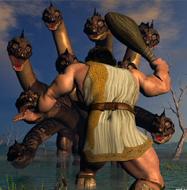 2. The attainment of moral integrity
2. The attainment of moral integrity
A person must have worked to gain control over his
debilitating self before he is even able to understand the existence or operation of a Higher realm from which inspiration emanates. The moral virtues a person must have achieved include having overcome the fear of unfamiliar experiences and having gained the courage to allow new, original ideas and processes to flow through him, without fear of criticism from others.
A crucial part of moral integrity is the acknowledgement that what inspiration we receive is NOT our own creation, but the receiving of elements from a higher source.
|
"Yet such is human nature that I still felt vanity as if this vision was mine, and I acted like one who comes across the treasure-house of a king, and spends the treasure as if it were his own. We may indeed have a personal wisdom, but spiritual vision is not to speak of as ours any more than we can say at the rising of the sun: 'This glory is mine.' By the sudden uprising of such vanities in the midst of vision I was often outcast, and found myself in an instant like those warriors of Irish legend, who had come upon a lordly house and feasted there and slept, and when they woke they were on the barren hillside, and the Faed Fia was drawn about that lordly house. Yet though the imagination apprehended truly that this beauty was not mine, and hailed it by its heavenly name, for some years my heart was proud, for as the beauty sank into memory it seemed to become a personal possession, and I said 'I imagined this' when I should humbly have said, 'The curtain was a little lifted that I might see.' "But the day was to come when I could not deny the Mighty Mother the reverence due, when I was indeed to know by what being I had been nourished, and to be made sweet and mad as a lover with the consciousness of her intermingling spirit."
AE (George William Russell), The Candle of Vision,1918 |
 3. The capability of controlling one's ordinary mind so it doesn't inhibit and discourage unfamiliar spiritual experiences and concepts.
3. The capability of controlling one's ordinary mind so it doesn't inhibit and discourage unfamiliar spiritual experiences and concepts.
If a person is ruled by a logical, over-rationalistic mind, it's impossible for him to achieve inspiration.
4. The ability to enter into a higher state of consciousness
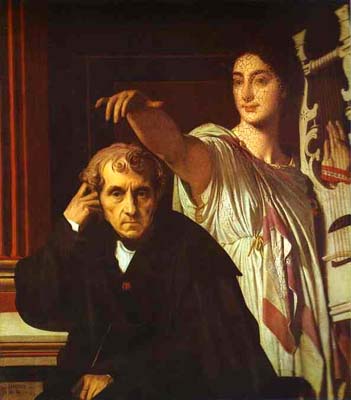 In his Ion, Plato explains that all enlightened poets create their poems not through following the ordinary rules of art but through attaining inspiration. This divine illumination occurs, as with inspired dancers, when they are not in their ordinary state of consciousness but, as it were, possessed by a divine Muse.
In his Ion, Plato explains that all enlightened poets create their poems not through following the ordinary rules of art but through attaining inspiration. This divine illumination occurs, as with inspired dancers, when they are not in their ordinary state of consciousness but, as it were, possessed by a divine Muse.
Attaining a higher--not merely an altered--state of consciousness is not easy for most persons. Perennialist preparatory material (such as this essay) provide means for serious seekers to learn how to enter into a higher state through specially prepared meanings, images, and exercises.
5. Acting on the understanding that we must prime the pump if we expect to receive the "water of life."
|
|
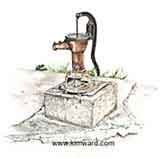 "In the middle of the arid Amalgosa desert, there stood a pump. A sealed can was hung on the handle of pump. In the can was a letter addressed 'To anyone seeking water.'
"In the middle of the arid Amalgosa desert, there stood a pump. A sealed can was hung on the handle of pump. In the can was a letter addressed 'To anyone seeking water.'
"The letter stated: 'This pump was installed in June 2003. There is plenty of underground water. I've arranged things so that anybody can get water from this pump for the next 5 years.
'But whoever wants to use the pump must first wet the seal within the pump in order to draw up water because the seal is too dry to create suction. Under the white rock beside the pump you'll find a sizeable bottle of water which you must use to prime the pump--not to drink! I've corked the bottle so tightly that the water cannot evaporate. There is only enough water for priming the pump, so don't drink it even if you're terribly thirsty.
'You must use the water in the bottle to drench the leather inside the pump. Then slowly pump the handle. If you do as I instruct, you'll get as much water as you want. Lastly, please fill the bottle and place it back under the rock and put the letter back in the can and seal it, just as I did.
'P.S. if you drink the water in the bottle, you'll never be able to use the pump.'" |
|
| Inspiration from the spiritual dimension is a direct response to the impelling force we create within ourselves. Whatever inspired ideas or intimations we receive, issue forth from a higher dimension in direct proportion to our self-invigoration. If we're only interested in taking knowledge for ourselves with no thought for assisting others, inspiration cannot flow through. Spiritual forces can only respond to selfless effort on our part. We must prime the pump if we expect to receive the "living water."
|
| "We cannot depend on this law [of inspiration] to accomplish anything more than the complement of our own efforts. One must depend on oneself to build one's aspirational column, knowing that at the highest stretch of one's hopes and efforts a capital will be placed beyond one's power to conceive." 7 |
Creative Inspiration As the Essence of Life
One way to describe the essence of life is in these terms:
"Filling all space . . . is a great sea of undifferentiated force. We can call it life, or spirit, or the Universal--anything we please. But it is the thing by virtue of which all living things exist, through their ability to transmute this general force into something individual. In other words . . . we are vital transformers. It follows that we are alive and developed in proportion to how much of this force we can accept, and how freely it flows through us. The better we do this the higher grade we occupy, and the more alive and contented and effective we become." 8
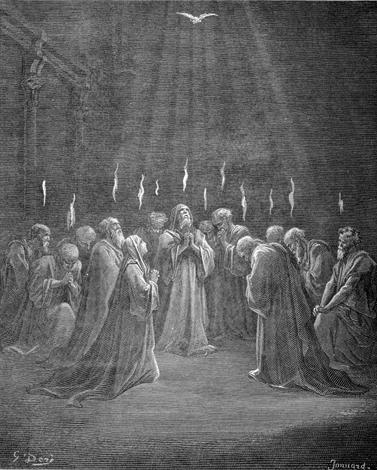 If a person has achieved self-awareness and moral integrity, the force he's able to manifest in the world, which we can call inspirational force, comes from a combination of conditions created by the person himself. Higher Entities can only take advantage of that combination. Once a person of his own force establishes it, Higher Forces can act on it. The initial step is the person's responsibility. This force is, roughly speaking, emanations from the person which meet complementary forces from the Higher realm.
If a person has achieved self-awareness and moral integrity, the force he's able to manifest in the world, which we can call inspirational force, comes from a combination of conditions created by the person himself. Higher Entities can only take advantage of that combination. Once a person of his own force establishes it, Higher Forces can act on it. The initial step is the person's responsibility. This force is, roughly speaking, emanations from the person which meet complementary forces from the Higher realm.
It's necessary to distinguish between positive and negative forces which a person can allow to flow through him. A person who has not achieved self-awareness and moral integrity, one who deliberately seeks to be influenced by negative or demonic ideas and images, is able to manifest terrible, destructive effects. America and the world are currently suffering from the destructive materialization of the diabolic depravity of a
gang of thugs that's taken control of economic, political, and ideological power worldwide.
"Perpetual inspiration is as necessary to the life of goodness, holiness
and happiness as perpetual respiration is necessary to animal life."
William Law |
How Do We Achieve Creative Inspiration?
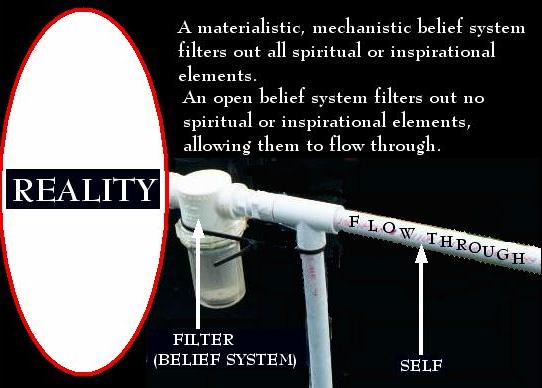 We reviewed above the necessary prerequisites for even starting on the quest for creative inspiration. There are additional essential elements that make inspiration possible, ideas and actions that are essential in encouraging the flow through of inspiration.
We reviewed above the necessary prerequisites for even starting on the quest for creative inspiration. There are additional essential elements that make inspiration possible, ideas and actions that are essential in encouraging the flow through of inspiration.
As illustrated to the right, our belief systems determine what elements of Reality--terrestrial and transcendent--can flow into and through us into manifestation. The "filter" of our belief system must be free of clogging elements such as egomania and greed.
Level of Being
Attributes
Entities
Faculties
Spiritual
Eternal
Unchanging
Forms
Higher Spiritual Powers
Higher Consciousness
Communion
Metaphysical
Intellectual
Nonmaterial
Higher Concepts
Higher Symbols
Higher Intellect
Inspiration
Terrestrial:
Conscious
Measurable
Tangible
Persons
Objects
Concepts
Lower Consciousness
Sensing, Feeling, Thinking
Terrestrial: Subconscious
Non-rational
Malleable
Images
Symbols
Unconscious,
Instinct
| | | | | | | | | | | | | | | | | | | | |
"Inspiration is not a suggestion of detail ready formed. It is a pouring in of all essence in a vital stream, from which the creator segregates and absorbs those things appropriate to his vision, as the organs and functioning mechanisms and tissues of the body take from the homogeneous blood stream those elements only which make for their health and building."
 "I hold an idea rather loosely when I get it. I take it as I would take the beauty of the rainbow.
I know I cannot hold it or reach it or even look at it closely. I know I can't, and so I don't try. That is the way I take these big ideas in the beginning--somewhat like the rainbow. I remember them wholly; but they are out of my reach in the analysis, the pulling of them to pieces to explain them."
"I hold an idea rather loosely when I get it. I take it as I would take the beauty of the rainbow.
I know I cannot hold it or reach it or even look at it closely. I know I can't, and so I don't try. That is the way I take these big ideas in the beginning--somewhat like the rainbow. I remember them wholly; but they are out of my reach in the analysis, the pulling of them to pieces to explain them."
|
"This unified consciousness cannot be imprisoned and shackled. Every glimpse of it you get must be felt in its life movement. It must be held lightly and loaned to others, passed freely and lavishly. One's function is to help conduct a flow--not to steal a cupful of something and run away with it." 9
|
| The instant of inspiration passing through you is your moment of divinity. |

Notes:
1 Inspiration:
- a divine influence or action on a person
held to qualify him to receive and communicate a higher
divulgence
- the quality or state of being inspired
- an inspiration agent or influence
Inspire:
- to breathe or blow into or upon
- to infuse (as life) by breathing [archaic]
- to influence, move, or guide by divine or supernatural
illumination
- to exert an animating, enlivening, or exalting influence
on
- to communicate to an agent supernaturally
- to bring about
2 Unforeseen, unexpected, not previously identified or ascertained
3 A dead lift is the lifting of a dead or inactive body, which must be done by sheer force. It is related to, somewhat opposite to the idea of dead weight: The weight of something without life; a burden that does nothing towards easing its own weight; a person who encumbers us and renders no assistance.
"It is just by determination and faith that you accomplish the first dead lift. That manifestation with yourself and by yourself, you must get before you will gain any response. That is what people do not realize. They don't put any strength into it, and when it will not work at once, they go the other way. You must get that strength for yourself."
Betty White, The Betty Book
4 Such testing of the capability of inspiration in dialectical interchange with a Perennialist teacher occurs in the introductory phase of Perennialist study, the next step up beyond the preparatory phase. Other, more elementary means are used to test for the incipient foreshadowings of inspiration in the preparatory phase.
5 Scry: to act as a crystal gazer in foretelling the future (Oxford English Dictionary)
6 In the New Testament, the word used to describe this revolutionary transformation is metanoia, which the Roman Catholic translators mangled into the Latin-based word "repent." To comprehend what this extraordinary concept of metanoia includes in its meaning, we must examine its original Greek connotations. It involves a person ceasing to cling to her ordinary life; old ideas and feelings lose all value for her. The whole course of her experience takes on a new meaning and leads in a totally different direction. She DIES completely to her old way of being and becomes--literally--a new person as she experiences a spiritual re-birth.
7 Betty and Stewart Edward White, Across the Unknown
8 Ibid.
9 Ibid.
 She does not try to contact a spiritual current so she can fill up a "pond" for her personal enjoyment; such a dead pool soon stagnates. It must be a living, moving stream which originates in the higher dimension and flows continuously to become transmuted into an effective life force.
She does not try to contact a spiritual current so she can fill up a "pond" for her personal enjoyment; such a dead pool soon stagnates. It must be a living, moving stream which originates in the higher dimension and flows continuously to become transmuted into an effective life force.

 William Blake spoke of his "friends in Eternity" as the source of poems that he received through "immediate dictation." He stressed the involuntary nature of this experience in which works were produced "without premeditation and even against my will." Blake's allusion to his "friends in Eternity" and their "dictations" indicates that inspiration occurs not only outside the mainstream of a person's conscious minds, but in an altogether different dimension of reality.
William Blake spoke of his "friends in Eternity" as the source of poems that he received through "immediate dictation." He stressed the involuntary nature of this experience in which works were produced "without premeditation and even against my will." Blake's allusion to his "friends in Eternity" and their "dictations" indicates that inspiration occurs not only outside the mainstream of a person's conscious minds, but in an altogether different dimension of reality. Mozart described his experience of inspiration as a process in which he applied the rules of counterpoint, adapting his inspired ideas to different instruments, until his composition stood "almost complete and finished in my mind, so that I can survey it, like a fine picture or beautiful statue, at a glance. Nor do I hear in my imagination the parts successively, but I hear them, as it were, all at once." This process, he said, "takes place in a pleasing lively dream."
Mozart described his experience of inspiration as a process in which he applied the rules of counterpoint, adapting his inspired ideas to different instruments, until his composition stood "almost complete and finished in my mind, so that I can survey it, like a fine picture or beautiful statue, at a glance. Nor do I hear in my imagination the parts successively, but I hear them, as it were, all at once." This process, he said, "takes place in a pleasing lively dream."  or totally content with your present life in the ordinary world, then don't even think about trying to work toward achieving inspiration--it simply can't happen within such a noxious atmosphere of egomania and self-satisfaction.
or totally content with your present life in the ordinary world, then don't even think about trying to work toward achieving inspiration--it simply can't happen within such a noxious atmosphere of egomania and self-satisfaction.  2. The attainment of moral integrity
2. The attainment of moral integrity 3. The capability of controlling one's ordinary mind so it doesn't inhibit and discourage unfamiliar spiritual experiences and concepts.
3. The capability of controlling one's ordinary mind so it doesn't inhibit and discourage unfamiliar spiritual experiences and concepts.  In his Ion, Plato explains that all enlightened poets create their poems not through following the ordinary rules of art but through attaining inspiration. This divine illumination occurs, as with inspired dancers, when they are not in their ordinary state of consciousness but, as it were, possessed by a divine Muse.
In his Ion, Plato explains that all enlightened poets create their poems not through following the ordinary rules of art but through attaining inspiration. This divine illumination occurs, as with inspired dancers, when they are not in their ordinary state of consciousness but, as it were, possessed by a divine Muse. "In the middle of the arid Amalgosa desert, there stood a pump. A sealed can was hung on the handle of pump. In the can was a letter addressed 'To anyone seeking water.'
"In the middle of the arid Amalgosa desert, there stood a pump. A sealed can was hung on the handle of pump. In the can was a letter addressed 'To anyone seeking water.'  If a person has achieved self-awareness and moral integrity, the force he's able to manifest in the world, which we can call inspirational force, comes from a combination of conditions created by the person himself. Higher Entities can only take advantage of that combination. Once a person of his own force establishes it, Higher Forces can act on it. The initial step is the person's responsibility. This force is, roughly speaking, emanations from the person which meet complementary forces from the Higher realm.
If a person has achieved self-awareness and moral integrity, the force he's able to manifest in the world, which we can call inspirational force, comes from a combination of conditions created by the person himself. Higher Entities can only take advantage of that combination. Once a person of his own force establishes it, Higher Forces can act on it. The initial step is the person's responsibility. This force is, roughly speaking, emanations from the person which meet complementary forces from the Higher realm. We reviewed above the necessary prerequisites for even starting on the quest for creative inspiration. There are additional essential elements that make inspiration possible, ideas and actions that are essential in encouraging the flow through of inspiration.
We reviewed above the necessary prerequisites for even starting on the quest for creative inspiration. There are additional essential elements that make inspiration possible, ideas and actions that are essential in encouraging the flow through of inspiration. "I hold an idea rather loosely when I get it. I take it as I would take the beauty of the rainbow.
I know I cannot hold it or reach it or even look at it closely. I know I can't, and so I don't try. That is the way I take these big ideas in the beginning--somewhat like the rainbow. I remember them wholly; but they are out of my reach in the analysis, the pulling of them to pieces to explain them."
"I hold an idea rather loosely when I get it. I take it as I would take the beauty of the rainbow.
I know I cannot hold it or reach it or even look at it closely. I know I can't, and so I don't try. That is the way I take these big ideas in the beginning--somewhat like the rainbow. I remember them wholly; but they are out of my reach in the analysis, the pulling of them to pieces to explain them."
